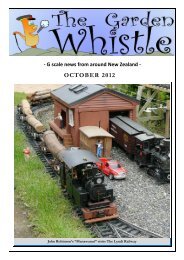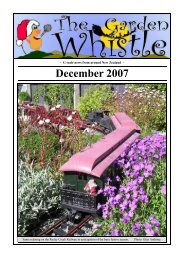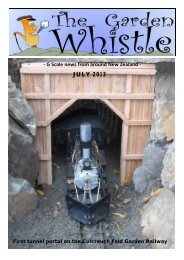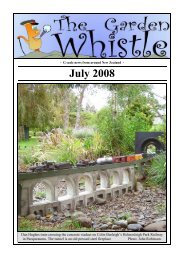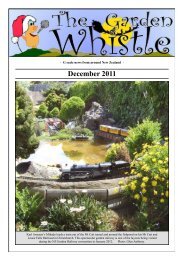Create successful ePaper yourself
Turn your PDF publications into a flip-book with our unique Google optimized e-Paper software.
By Kevin Leigh (Christchurch)<br />
The <strong>Garden</strong> <strong>Whistle</strong> - November 2011<br />
The <strong>Garden</strong> <strong>Whistle</strong> - <strong>Apr</strong>il <strong>2012</strong><br />
NZR Chopper couplers 1/24<br />
( fabricated in brass )<br />
This article will briefly explain how I fabricated NZR style buffers for use on 1/24 scale or<br />
‘G’ gauge loco’s and rolling stock. They are not 100% accurate to the prototype ,but they work<br />
well and are convincing enough. They're inexpensive to build, using, readily available brass<br />
stock from the K&S stand.<br />
A<br />
1<br />
2<br />
K&S Brass Shapes<br />
1. 3/8” x 3/16” -hollow rectangle<br />
2. 5/32” x 5/32” -hollow square<br />
3. 1/8” x 1/8” -hollow/solid square<br />
4. 3/32” x 1/32” -strip<br />
5. 1/2” x 1/16” -strip,( to cut disc from) or .<br />
5b. 1/2” -round bar, (cut discs<br />
on lathe, or, by hand )<br />
6. 0.8mm -brass wire or equivalent<br />
7. 1/16” -brass rod / wire<br />
The buffer face, shown here was cut from a piece<br />
of 1/2 inch bar stock, with a 3.5mm hole bored<br />
into it. It can alternatively be made using 1/2” x<br />
1/16” flat strip and scribing 11.64mm circles and<br />
drilling out the 3.5mm hole, cutting out the disc<br />
with a piercing saw ,then filing the outer edge<br />
smooth. The curve on the buffer face can be<br />
formed once the whole buffer has been fabricated.<br />
For now we only need a disc with a hole in it.<br />
A<br />
slot<br />
3<br />
B<br />
4<br />
The buffer head was formed by taking the length<br />
of (3/8 x 3/16) hollow rectangle and drilling a series<br />
of 3.5mm through holes about 20mm apart.<br />
The hole on one side was then filed square to allow<br />
the (5/32 ) hollow square to fit in.<br />
A slot was made in the (5/32) hollow square only<br />
big enough to allow space to get a file into the gap<br />
later.<br />
Don’t file the slot smooth yet. The remaining side<br />
walls will be used to guide the 1/8 bar, and keep it<br />
square while on the soldering jig.<br />
A<br />
slot<br />
B<br />
The hollow (5/32) square was then inserted into the<br />
square hole in the (3/8 x 3/16) rectangle hollow<br />
and pushed right in.<br />
Once firmly seated the hollow square was trimmed<br />
off .<br />
Page 18



